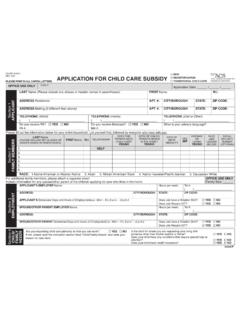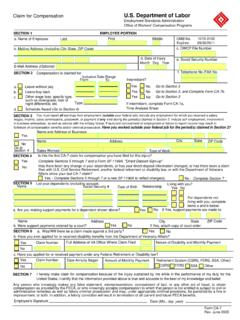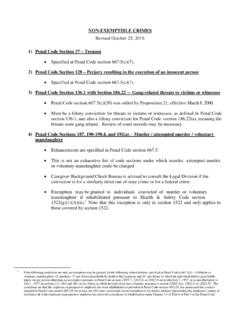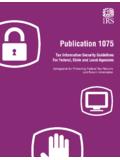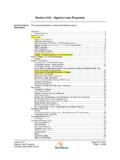Transcription of Section E. Non-Employment Related Borrower Income …
1 HUD Chapter 4, Section E. Section E. Non-Employment Related Borrower Income Overview In This Section This Section contains the topics listed in the table below. Topic Topic Name See Page 1 Alimony, child Support, and Maintenance 4-E-2. Income 2 Investment and Trust Income 4-E-4. 3 Military, Government Agency, and Assistance 4-E-7. Program Income 4 Rental Income 4-E-10. 5 Non-Taxable and Projected Income 4-E-15. 4-E-1. Chapter 4, Section E HUD 1. Alimony, child Support, and Maintenance Income Introduction This topic contains information on alimony, child support, and maintenance Income requirements, including alimony, child support, and maintenance Income criteria, and TOTAL Scorecard Accept/Refer requirements for alimony, child support and maintenance Income .
2 Change Date March 1, 2011. Alimony, child support, or maintenance Income may be considered effective, Alimony, child if Support and Maintenance payments are likely to be received consistently for the first three years of the Income Criteria mortgage the Borrower provides the required documentation, which includes a copy of the final divorce decree legal separation agreement, court order, or voluntary payment agreement, and the Borrower can provide acceptable evidence that payments have been received during the last 12 months, such as cancelled checks deposit slips tax returns, or court records. Notes: Periods less than 12 months may be acceptable, provided the lender can adequately document the payer's ability and willingness to make timely payments. child support may be grossed-up under the same provisions as non- taxable Income sources.
3 Reference: For more information on grossing-up, see HUD Continued on next page 4-E-2. HUD Chapter 4, Section E. 1. Alimony, child Support, and Maintenance Income , Continued The Technology Open To Approved Lenders (TOTAL) Scorecard TOTAL Accept/Approve and Refer recommendations for alimony, child support, and Scorecard maintenance Income require evidence Accept/Refer Requirements of receipt, using deposits on bank statements or cancelled checks for the for Alimony, child Support most recent three months that support the amount used when qualifying, and and that the claimed Income will continue for at least three years. Maintenance Income For the financial details, the underwriter should use the front and pertinent pages of the divorce decree, settlement agreement and/or court order.
4 Reference: For more information on the TOTAL Scorecard recommendations, see the TOTAL Mortgage Scorecard User Guide. 4-E-3. Chapter 4, Section E HUD 2. Investment and Trust Income Introduction This topic contains information on analyzing investment and trust Income , including analyzing interest and dividends trust Income notes receivable Income , and calculating qualifying ratios for investment properties. Change Date March 1, 2011. Interest and dividend Income may be used for qualifying as long as tax Analyzing returns or account statements support a two-year receipt history. This Income Interest and must be averaged over two years. Dividends The underwriter should subtract any funds derived from these sources that are required for the cash investment, before calculating the projected interest or dividend Income .
5 Income from trusts may be used for qualifying if guaranteed, constant Trust Income payments will continue for at least the first three years of the mortgage term. Required trust Income documentation includes a copy of the Trust Agreement or other trustee statement, confirming the amount of the trust frequency of distribution, and duration of payments. The Borrower may withdraw funds from the trust account to use for the required cash investment if he/she provides adequate documentation that this withdrawal will not negatively affect the amount of trust Income the underwriter used to determine repayment ability. Continued on next page 4-E-4. HUD Chapter 4, Section E. 2. Investment and Trust Income , Continued In order to include notes receivable Income to qualify a Borrower , he/she must Notes provide Receivable Income a copy of the note, to establish the amount and length of payment, and evidence that these payments have been consistently received for the last 12.
6 Months, in the form of deposit slips cancelled checks, or tax returns. If the Borrower is not the original payee on the note, the lender must establish that the Borrower is now a holder in due course, and able to enforce the note. The underwriter should follow the steps in the table below to calculate an Calculating investment property's Income or loss, whether the property to be insured is an Qualifying eligible investment property, or sold through FHA's Real Estate Owned Ratios for (REO) program. Eligible Investment Properties Step Action 1 Subtract the total monthly housing payment of principal, interest, taxes and insurance (PITI) from the monthly net rental Income of the subject property. Note: Calculate the monthly net rental by taking the gross rents, and subtracting the 25% reduction, or the applicable Homeownership Center's (HOC) percentage reduction for vacancies and repairs.
7 2 Does the calculation in Step 1 yield a positive number? If yes, add the number to the Borrower 's monthly gross Income . If no, include the number as a recurring monthly obligation. Continued on next page 4-E-5. Chapter 4, Section E HUD 2. Investment and Trust Income , Continued Calculating Qualifying Ratios for Eligible Investment Properties (continued). Step Action 3 Calculate the mortgage payment-to- Income ratio (top or front-end ratio) by dividing the Borrower 's current housing expense on his/her principal residence by the monthly gross Income . Note: The monthly gross Income includes any positive cash flow from the subject investment property. 4 Calculate the total fixed payment-to- Income ratio (bottom or back- end ratio) by dividing the Borrower 's total monthly obligations, including any net loss from the subject investment property, by the Borrower 's total monthly gross Income .
8 4-E-6. HUD Chapter 4, Section E. 3. Military, Government Agency, and Assistance Program Income Introduction This topic contains information on analyzing military, government agency, and assistance program Income , including military Income VA benefits government assistance programs mortgage credit certificates, and Section 8 home ownership vouchers. Change Date March 1, 2011. Military personnel receive base pay, and are often entitled to additional forms Military of pay, such as Income variable housing allowances clothing allowances flight or hazard pay rations, and proficiency pay. These types of additional pay are acceptable when analyzing a Borrower 's Income as long as the probability of such pay to continue is verified in writing. Note: The tax-exempt nature of some of the above payments should also be considered.
9 Reference: For information about non-taxable Income , see HUD Continued on next page 4-E-7. Chapter 4, Section E HUD 3. Military, Government Agency, and Assistance Program Income , Continued Direct compensation for service- Related disabilities from the Department of VA Benefits Veterans Affairs (VA) is acceptable Income for qualifying, provided the lender receives documentation from the VA. Education benefits used to offset education expenses are not acceptable. Income received from government assistance programs is acceptable for Government qualifying, as long as the paying agency provides documentation indicating Assistance that the Income is expected to continue for at least three years. Programs If the Income will not be received for at least three years, it may be considered as a compensating factor.
10 Unemployment Income must be documented for two years, and there must be reasonable assurance that this Income will continue. This requirement may apply to seasonal employment . Reference: For information on analyzing Income from seasonal employment , see HUD If a government entity subsidizes the mortgage payments either through direct Mortgage payments or tax rebates, these payments may be considered as acceptable Credit Income . Certificates Either type of subsidy may be added to gross Income , or used directly to offset the mortgage payment, before calculating the qualifying ratios. Continued on next page 4-E-8. HUD Chapter 4, Section E. 3. Military, Government Agency, and Assistance Program Income , Continued A monthly subsidy may be treated as Income if a Borrower is receiving Section 8 Home subsidies under the housing choice voucher home ownership option from a Ownership Public Housing Agency.











